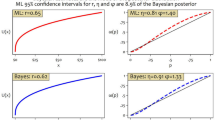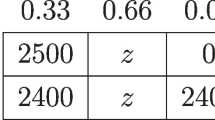Abstract
We provide a simple model to measure the impact of aggregate risks. We consider agents whose rankings of lotteries over vectors of outcomes satisfy expected utility and separability. Such rankings are characterized in terms of aggregative utilities that measure sensitivity to aggregate uncertainty in a straightforward way. We consider applications to models of product variety, portfolio choice, and public attitudes towards catastrophic risks. The framework lends support to precautionary measures that penalize policies for exposure to correlation. The model rationalizes a number of behavioral and policy patterns as attempts to hedge against aggregate uncertainty.

Similar content being viewed by others
Notes
See Sect. 3.4’s discussion of the seminal Dixit–Stiglitz model of consumer choice with product varieties.
Since the operations of summing over the population and integrating over states commute, the utility of a lottery depends only on its marginals on the coordinates \(s_1, \ldots , s_n\), forcing indifference to correlation. See equation (4).
It is crucial that the utility function (1) is unique up to a common positive affine transformation. Multiplication by \(1\over n\) is innocuous and simplifies comparisons across different \(n\)’s. The formal structure of Debreu’s theorem is reviewed below.
For example, the United Nations Framework Convention on Climate Change, the 1992 Rio Declaration, the Treaty Establishing the European Community, the U.S. National Environmental Policy Act, and the U.S. Clean Water Act. One of the best known statements of this policy principle is “Wingspread Declaration” which states that “When an activity raises threats of harm to human health or the environment, precautionary measures should be taken even if some cause-and-effect relationships are not fully established scientifically.” Ashford et al. (1998). See Sunstein (2005) for a review and critique of this principle and Al-Najjar (2015) for a different perspective on the issue.
To avoid unnecessary repetition, probability measures on complete separable metric spaces are defined on their Borel \(\sigma \)-algebras. All product spaces, such as \(S\), are given their product topologies and corresponding \(\sigma \)-algebras. All subsets are assumed to be measurable unless otherwise noted.
This formulation simplifies the exposition by forcing the conclusion of the law of large numbers to hold exactly for any \(n\). Since \(s_\alpha \) is chosen uniformly, individual outcomes are identically distributed, but not independent. They are, however, “nearly” independent, in the sense that correlation between any two outcomes decreases to zero as \(n\) increases. Finally, note that we implicitly assume \(\alpha \) to be a multiple of \(1\over n\) to ensure that \(S_\alpha \) is well-defined.
Assuming non-triviality, continuity, and a version of the structural conditions above, Gorman (1968) extends Debreu’s theorem to partial separability.
The assumption that \(v_i=v\) for all \(i\) is not completely innocuous. Suppose that, for some vector \((q_1, \ldots , q_n)\) of probabilities on \(\{1,\ldots , n\}\), the function \(\hat{V}(s)= \sum _i q_i \hat{v}_i(s_i)\) is another cardinal representation of \(V(s) = n^{-1} \sum _i v_i(s_i)\). Since utility is unique up to a common positive affine transformation, requiring \(v_i=v\) for all \(i\) in V forces \(q_i={1\over n}\) for all \(i\) in \(\hat{V}\). Without this requirement, the “probabilities” with which various individuals are drawn are indeterminate. While this indeterminacy does affect the point being made here, it also adds a degree of freedom that may confound the issue.
In the sense that \(\hat{V}(s)\ge \hat{V}(s')\) if and only if \(U(s)\ge U(s')\) for any \(s, s'\).
In Barberis and Huang (2001), a narrow framing may reflect “utility unrelated to consumption. [...] An investor may interpret a big loss on a stock as a sign that he is a second-rate investor, thus dealing his ego a painful blow, and he may feel humiliation in front of friends and family when word about the failed investment leaks out.”
This is one of many aggregators considered in their paper. We focus on the finite-variety version of the Dixit–Stiglitz aggregator; the framework of our companion paper, Al-Najjar and Pomatto (2014), can be used to model the infinite variety case.
Note that \(U(\alpha s) = \left( {1\over n}\sum _i (\alpha \ s_i)^\rho \right) ^{{\kappa \over \rho }} = \alpha ^\kappa \, U(s) \) and differentiate with respect to \(\alpha \).
If \(n\) were infinite, then de Finetti’s theorem characterizes conditionally i.i.d. distributions as those that are invariant to permutations (or exchangeable). This equivalence does not hold for finite \(n\).
An example is the Precautionary Principle, according to which “When an activity raises threats of harm to human health or the environment, precautionary measures should be taken even if some cause-and-effect relationships are not fully established scientifically.” “Wingspread Statement on the Precautionary Principle,” Ashford et al. (1998). See Sunstein (2005) for a review and critique of this principle and Al-Najjar (2015) for a different perspective on precautionary policies.
When the population is small (e.g., \(n=2\)) and \(u\) is non-linear, there will typically be “aggregate uncertainty” even if \(P\) is independent.
An important restriction, discussed below, is that the status quo is deterministic.
This assumption simplifies the example, but may be inconsistent with the new treatment having a well-defined utility. Note that we do not need to calculate the expected utility of the new treatment in this example.
That is, \(A_\delta \) is the uniform distribution on the finite set \(\left\{ a: \sum _i a_i= n\delta \right\} \).
See Robson and Samuelson (2010)’s survey for discussion of the principal-agent approach.
Fishburn’s theorem requires only that indifference obtains for lotteries that are either degenerate or assigns equal weights to the two deterministic profiles.
References
Acharya, V. V., Pedersen, L. H., Philippon, T., & Richardson, M. P. (2010). Measuring systemic risk. New York: NYU Stern School of Business.
Adrian, T., & Brunnermeier, M. K. (2011). CoVaR. Cambridge: National Bureau of Economic Research.
Al-Najjar, N. I. (2015). A Bayesian framework for the precautionary principle. Journal of Legal Studies, Forthcoming.
Al-Najjar, N. I., & Pomatto, L. (2014). Aggregative utility in large populations. Evanston: Northwestern University.
Ashford, N. et al. (1998). Wingspread statement on the precautionary principle. Retrieved from http://www.gdrc.org/u-gov/precaution-3.html.
Barberis, N., & Huang, M. (2001). Mental accounting, loss aversion, and individual stock returns. The Journal of Finance, 56(4), 1247–1292.
Bergstrom, T. C. (1997). Storage for good times and bad: Of squirrels and men. Santa Barbara: University of California, Santa Barbara.
Cooper, W. S., & Kaplan, R. H. (1982). Adaptive “coin-flipping”: A decision-theoretic examination of natural selection for random individual variation. Journal of Theoretical Biology, 94(1), 135–151.
Debreu, G. (1960). Topological methods in cardinal utility theory. In K. Arrow, G. Karlin, & P. Suppes (Eds.), Mathematical methods in the social sciences (pp. 16–26). Stanford: Stanford University Press.
Dixit, A. K., & Stiglitz, J. E. (1977). Monopolistic competition and optimum product diversity. The American Economic Review, 67(3), 297–308.
Fishburn, P. (1970). Utility theory for decision making. New York: Wiley.
Gilboa, I., & Schmeidler, D. (1989). Maxmin expected utility with nonunique prior. Journal of Mathematical Economics, 18(2), 141–153.
Gorman, W. M. (1968). The structure of utility functions. The Review of Economic Studies, 35, 367–390.
Halevy, Y., & Feltkamp, V. (2005). A Bayesian approach to uncertainty aversion. Review of Economic Studies, 72(2), 449–466.
Manski, C. F. (2004). Statistical treatment rules for heterogeneous populations. Econometrica, 72(4), 1221–1246.
Manski, C. F. (2011). Choosing treatment policies under ambiguity. Annual Review of Economics, 3(1), 25–49.
Manski, C. F., & Tetenov, A. (2007). Admissible treatment rules for a risk-averse planner with experimental data on an innovation. Journal of Statistical Planning and Inference, 137, 1998–2010.
McDiarmid, C. (1998). Concentration. Oxford: University of Oxford.
Robson, A. (1996). A biological basis for expected and non-expected utility. Journal of Economic Theory, 68, 397–424.
Robson, A., & Samuelson, L. (2010). The evolutionary foundations of preferences. In J. Benhabib, A. Bisin, & M. Jackson (Eds.), The social economics handbook. Amsterdam: Elsevier Press.
Savage, L. J. (1954). The foundations of statistics. New York: Wiley.
Schmeidler, D. (1989). Subjective probability and expected utility without additivity. Econometrica, 57(3), 571–587.
Sunstein, C. (2005). Laws of fear: Beyond the precautionary principle. Cambridge: Cambridge University Press.
Wakker, P. (1991). Continuity of transformations. Journal of Mathematical Analysis and Applications, 162(1), 1–6.
Acknowledgments
We thank Robert Gary-Bobo, Yoram Halevy, Chuck Manski, Mallesh Pai, and Phil Reny for their comments. We also thank Hasat Cakkalkurt for her research assistance.
Author information
Authors and Affiliations
Corresponding author
About this article
Cite this article
Al-Najjar, N.I., Pomatto, L. Choice under aggregate uncertainty. Theory Decis 80, 187–209 (2016). https://doi.org/10.1007/s11238-015-9504-1
Published:
Issue Date:
DOI: https://doi.org/10.1007/s11238-015-9504-1




